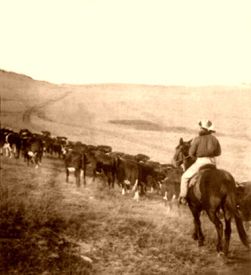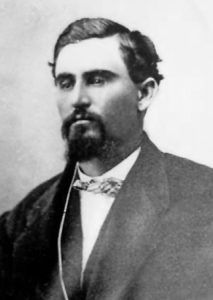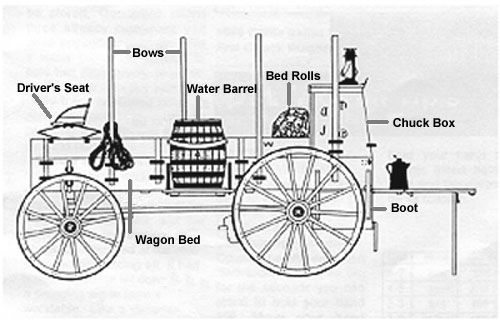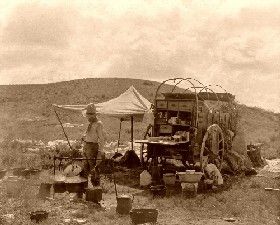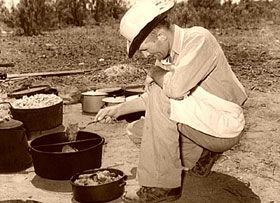Outside of the “round-up,” there just might be no more identifiable image for the cowboy and cattle trail of the Old West than that of the Chuck Wagon.
Some people may think that a Chuck Wagon was part of every traveling caravan. However, this was not the case. The Chuck Wagon was invented specifically for the use of the Texas cowboys who were driving their herds along the trail to the closest railhead or market.
While some form of mobile kitchens existed along the overland trails for generations, the invention of the Chuck Wagon is attributed to Charles Goodnight, a Texas rancher and co-founder of the Goodnight-Loving Trail.
Before the railroad reached Texas, the competition was stiff in recruiting good cowboys willing to spend the long weeks on the cattle trail driving large herds to the Kansas railheads or markets in other states. In the early days of the great trail drives, each cowboy was responsible for his meals and had to make do with what he could carry with him.
Charles Goodnight saw this as not only a problem but also as an opportunity to hire the best cowboys and soon came up with a solution. In 1866, he created the prototype for the Chuck Wagon by purchasing a Studebaker wagon, a durable army-surplus wagon, and hiring a good cook. With the help of the cook, the two outfitted the wagon with steel axles that could withstand the rugged terrain and added boxes, shelves, and drawers for the cook. The two developed an efficient layout with a “chuck box” at the back of the wagon, which was a sloping box with a hinged lid that lay down to provide a flat working surface. Inside the chuck box were drawers and shelves to hold cooking tools and supplies. Beneath the chuck box was a “boot” to hold larger items such as the ever-present Dutch oven. The average chuck wagon was about 10 feet long and 38-40 inches wide.
A water barrel and coffee mill were attached to the outside of the wagon, and canvas or cowhide, called the “possum belly,” was suspended beneath to carry firewood and cow chips. Waterproof tarps held up by bows covered the wagon to keep everything dry. A Chuck Wagon “fly”, or canvas awning, was often attached to the top of the chuck box that could be rolled out in case of rain. In front of some of the wagons was a jockey box, which was used for storing tools and heavier equipment needed on the trail. Larger ranches often had a second wagon to carry bedrolls, tents, spare saddles, and extra supplies. However, in smaller outfits, the wagon box of the chuck wagon was used to carry the drover’s personal items and bedrolls, as well as any other needed items such as bulk food supplies, water, tools, feed for the horses, medicine, needles, and thread. The Chuck Wagon was sometimes drawn by oxen, but more often by mules. Before long, the chuck wagon was adopted by trail drovers across the West, as well as loggers, prospectors, and others traveling in groups.
The term “Chuck Wagon” is attributed to two different sources: one says it was named after “Chuck” Goodnight, and the other says it comes from the slang term for food—“chuck.”
The food carried in the chuck wagon was generally easy to preserve, such as beans, salted meats, coffee, onions, potatoes, lard, and flour to make biscuits. Beef was never in short supply, and a good Chuck Wagon cook knew how to prepare it in many different ways. Fried steak was the most common and also the general favorite, but pot roasts, short ribs, and stew were often served.
A general perception of the chuck wagon was that the cowboys lived on beans. Though the cook sometimes did make them, it was not that common, as they took too long to cook. The cook was not limited to only those items stored in the chuck wagon, as food was also gathered en route.
On these long trail drives, which were often as much as 1,000 miles in length and could last as long as five months, the cook became an essential part of the team, even more so than the trail drivers.
Second only to the Trail Boss, the cook not only made the meals along the trail, but also acted at times as barber, dentist, and banker. As the only real benefit on the long cattle trail, the morale of the men and the smooth functioning of the camp depended largely upon him, so much so that even the Trail Boss often deferred to him. A trail boss was usually paid about $100 to $125 a month, the cook about $60, and the drovers, from $25 to $ 40.
The cook became so crucial to the trail drive, that he was soon dubbed with a number of nicknames including Coosie and Cookie, which were the most common; but also gained a number of others, such as Soggy, Pot Rustler, Lean Skillet, Old Pud, Old lady, Belly Cheater, Biscuit Roller, Dough Boxer, Dough Puncher, Greasy Belly, Grub Worm, Gut Robber, Sourdough, and more. Even though some of these nicknames were not necessarily complimentary, and wagon cooks often had the reputation of being ill-tempered, not a soul on the crew ever dared to complain. Breakfast and dinner were the highlights of the day. On the other hand, a cook who didn’t get the meals ready on time would be very quickly subject to ridicule.
So why was Cookie so ill-tempered? Especially given the fact that he didn’t work as hard as the drovers during the day? While his job may not have required as much effort during daylight hours, he was continually operating on less sleep and still had to be awake to drive the chuck wagon, constantly look for and gather fuel, including wood and cow chips, and collect additional food supplies along the way.
His job required that he get up earlier than the cowhands, usually before the first light of dawn, to have coffee and breakfast ready for the crew. After the men had saddled up and left, the cook washed, dried, and put away the dishes and cooking utensils, packed the bedrolls and any food supplies in the wagon, and hitched up the team to move on to the next camp.
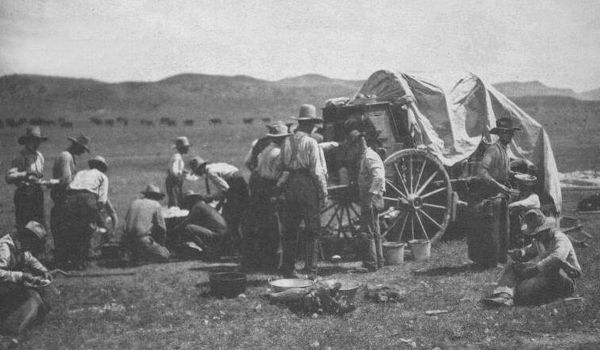
Cowboys near Silver City, New Mexico.
In the evening, he had to move quicker than the crew in order to be at the appointed camp and have a hot meal ready when they arrived. In addition to cooking the meal, if Cookie was feeling kindly toward “the boys,” he would make a dessert, which usually consisted of a pie or pastry.
Dinner around the chuck wagon was the highlight of the day and has been described as pleasantly barbaric, as one might expect with a group of hard-working men out in the elements. Though the talk was colorful and often filled with profanity, there were definite “unwritten” rules to be followed around the chuck wagon. Some of these included never tying a horse to the chuck wagon or even close so that dust wouldn’t blow into the food. Approaching riders always stayed downwind from the chuck wagon, and the Cowboys were not allowed to be scuffling about for the same reason.
The Cowboys also knew not to “mess” with the cook, including never crowding around his fire for warmth, never touching his cooking tools, helping himself to a bite before dinner, or using his work table for any reason. The cowboys sat on the ground to eat, and during the meal, there were more unwritten rules, including that no cowboy was to take the last piece of anything unless he was sure the rest of the group was through eating. If a man refilled his coffee cup, and someone yelled, “Man at the pot,” he was supposed to fill all the cups held out to him as well as his own.
After a meal, the cowboys always scraped their plates clean and put them in the “wrecking pan,” a big dishpan set aside for the cook to wash. After washing the dishes, filling the water barrel, and dragging wood, the cook could finally relax and enjoy what was left of the evening.
The high time of the trail drives lasted only about 20 years, from the end of the Civil War to the mid-1880s. During those two decades, about ten million cows walked the trails from Texas to the railheads in Kansas and Missouri. Many of these went as far as Wyoming and even into Canada. A number of the markets that the cattle were driven to quickly evolved into lawless towns, especially in Kansas. Some of these included wicked Dodge City, Abilene, dubbed the Queen of the Cowtowns, and Ellsworth, to name a few.
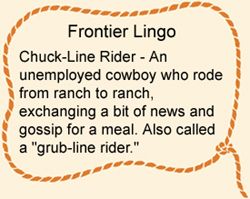
Chuck Wagon Etiquette
- No one eats until Cookie calls
- When Cookie calls, everyone comes a runnin’
- Hungry cowboys wait for no man. They fill their plates, fill their bellies, and then move on so stragglers can fill their plates.
- Cowboys eat first, talk later.
- It’s okay to eat with your fingers. The food is clean
- If you’re refilling the coffee cup and someone yells, “Man at the pot.” You’re obliged to serve refills.
- Don’t take the last serving unless you’re sure you’re the last man.
- Food left on the plate is an insult to the cook.
- No running or saddling a horse near the wagon. And when you ride off, always ride downwind from the wagon.
- If you come across any decent firewood, bring it back to the wagon
- Strangers are always welcome at the wagon.
Did you know?
When Cookie was finished with his work for the day and before hitting the sack, he would always place the tongue of the chuck wagon facing north. When the trail master started in the morning, he would look at the tongue and then know which direction he would be moving the herd.
©Kathy Alexander/Legends of America, updated May 2025.
Another fun video from our friends at Arizona Ghostriders.


